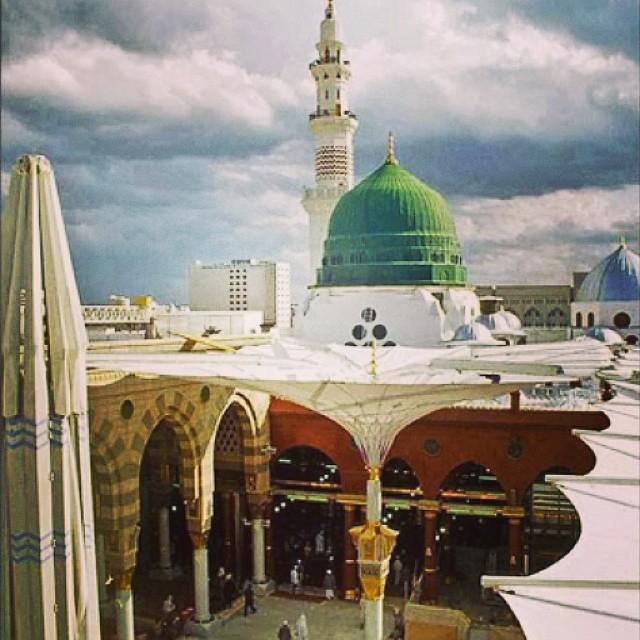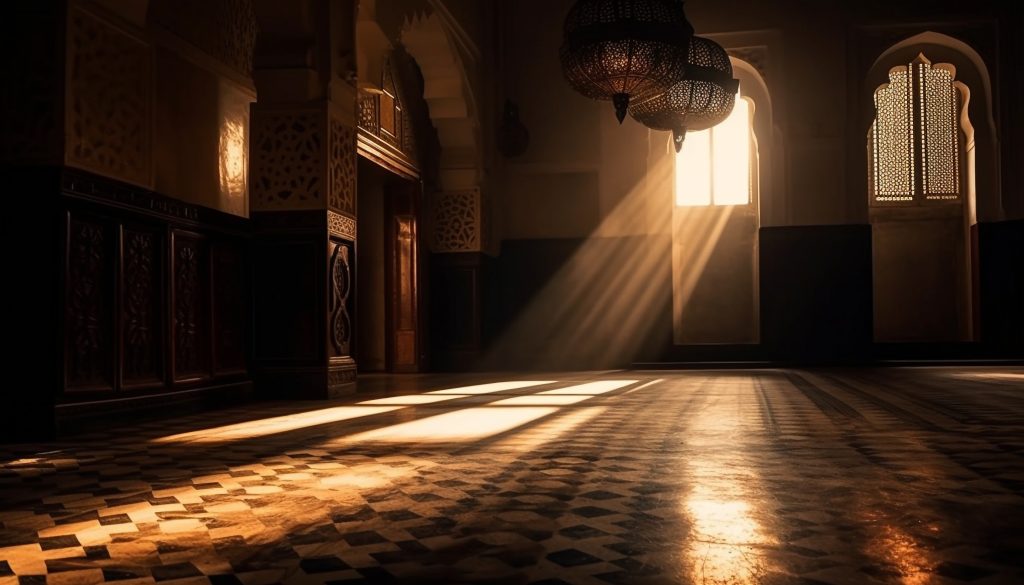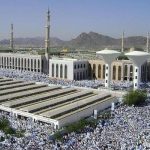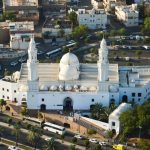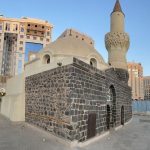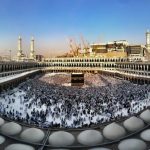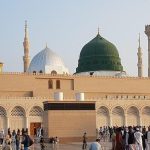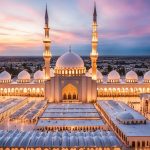Introduction
Mount Uhud is a prominent geographical and historical landmark located in Al-Madinah al-Munawwarah, in the western region of the Kingdom of Saudi Arabia. Situated just four kilometers from the Prophet’s Mosque, it holds a significant place in Islamic history, most famously associated with the Battle of Uhud. This pivotal conflict, which took place during the early days of Islam, involved the Muslims defending their nascent community against the Quraysh. The battlefield is especially notable for the martyrdom of seventy Companions, including Hamzah bin Abdulmuttalib, the uncle of the Prophet Muhammad (peace be upon him), who is revered in Islamic tradition as the Chief of the Martyrs.
As a site of profound historical and spiritual importance, Mount Uhud serves as a focal point for both pilgrims and scholars, offering rich insights into the early Islamic period. This research blog, part of the Umrah International initiative, aims to explore the enduring legacy of Mount Uhud, its connection to the Prophet (peace be upon him), and its relevance to contemporary Islamic thought and practice. By examining the multifaceted dimensions of this remarkable mountain, we seek to deepen the understanding of its significance for Muslims today and its role in the spiritual journey of Umrah.
Significance of Mount Uhud
Mount Uhud is celebrated as one of the most significant Islamic and tourist sites linked to the prophetic biography and historical events. It attracts a multitude of visitors year-round, serving as one of the enduring historical landmarks in Al-Madinah al-Munawwarah. The Prophet Muhammad (PBUH) stated, “Uhud is a mountain that loves us and we love it,” a proclamation that has cultivated a profound affection for the mountain among Muslims and fosters a desire for pilgrimage to the site.
Recognizing its historical and cultural significance, Mount Uhud has undergone various beautification and development initiatives. The nighttime lighting design complements the natural beauty of the mountain, drawing inspiration from the sunrise over its peaks. Enhanced pathways have been established to facilitate the movement of visitors, thus improving accessibility to this historic site.
Historical Context of Mount Uhud
The history of Mount Uhud is intricately connected to the battle fought in 625 CE, during the third year of Hijra (Islamic calendar). This conflict was waged between the Muslims, led by Prophet Muhammad (PBUH), and the Quraysh, who were allied with tribes from Kinanah and Tihama under the command of Abu Sufyan bin Harb. The Muslim forces consisted of approximately one thousand individuals, while the Quraysh and their allies numbered around three thousand.
Etymology of “Uhud”
The name “Uhud” is derived from three distinct narratives regarding its origin. The first posits that it was named for its unique terrain, which sets it apart from other mountains and is surrounded by plains and valleys. The second narrative suggests that it was named after a giant named Uhud, who is believed to have been the mountain’s first inhabitant. According to the third narrative, the name symbolizes the oneness of Allah.
Historical Relics at Mount Uhud
Mount Uhud is home to several historical inscriptions, some of which contain significant phrases that date back over five centuries. Among these relics is the Fasah Mosque, where the Prophet Muhammad (PBUH) performed the Dhuhr and Asr prayers on the day of the Battle of Uhud. Additionally, a small mosque located near Mount Uhud, which leads to al-Mihras, has been integrated with modern structures and is surrounded by a few traditional houses, most of which have been demolished. Only a small portion of these structures remains, now fenced by the Al-Madinah Municipality. Moreover, Mount al-Rumah is noteworthy as the location from which some Muslims launched arrows during the battle.
Natural Features of Mount Uhud
Rising over one thousand meters above sea level, Mount Uhud supports a diverse ecosystem with more than eight species of plants. The mountain is characterized by volcanic and igneous rocks of various colors, with some formations dating back to the Cretaceous period. Natural cavities on the mountain serve as reservoirs, retaining rainwater for use until the next rainy season.
Mount Uhud is part of an extensive range of interconnected mountains, extending approximately eight kilometers in length and two kilometers in width on its eastern side, while on its western side, it stretches over three kilometers. Positioned to the north of Al-Madinah al-Munawwarah, it lies four kilometers from the Prophet’s Mosque, with its highest peak measuring approximately 1,077 meters above sea level.
Boundaries of Mount Uhud
To the east, Mount Uhud is bordered by al-Matar Road, Mount Tayab, and Mohammed bin Abdulwahab Primary School. To the south, it is adjacent to the Al-Shuhada District, agricultural lands at its foothills, and the Martyrs’ Cemetery. A canal valley runs parallel to it, approximately one thousand meters away. To the west, it is bordered by the Al-Tayariyah neighborhood, farmlands, and al-Eyun Road. To the north, it is flanked by a road utilized by non-Muslims and livestock markets.
Vegetation of Mount Uhud
The plateaus of Mount Uhud are adorned with a diverse array of flora, including the Prophet’s Almond, a small plant distinguished by broad, arranged leaves. Other notable plant species include the Ruby dock (Rumex vesicarius), known for its sour taste and pink leaves, alongside Arabian boxthorn (Lycium shawii), Acacia tortilis (Vachellia tortilis), Salam (Acacia ehrenbergiana), Sidr (Frangula alnus), Colocynth (Citrullus colocynthis), and camel thorn (Vachellia erioloba). This rich biodiversity contributes to the ecological significance of Mount Uhud, making it an important site for both historical and environmental study.
Jabal Uhud: A Profound Emotional Connection
Jabal Uhud holds a deep emotional significance in relation to our beloved Prophet Muhammad (ﷺ). Much like the trunk of a palm tree that wept in longing for him, Jabal Uhud shares a similarly poignant bond. The Prophet (ﷺ) famously stated, “This is a mountain that loves us, and we love it” (هَذَا جَبَلٌ يُحِبُّنَا وَنُحِبُّهُ), as narrated by Anas ibn Malik in Sahih al-Bukhari.
Scholars such as Ibn Abd al-Barr have contemplated the implications of this hadith. They ponder whether the mountain, by divine decree, possesses the ability to feel and express affection for the Prophet (ﷺ), or if it serves as a metaphor for the profound connection between believers and this sacred site. Some scholars even refer to Jabal Uhud as a living companion (sahabi) of the Prophet (ﷺ). As we approach the mountain, we can feel the same love articulated by the Prophet (ﷺ), with the very rocks echoing the sacrifices made by those who traversed its slopes to uphold their faith.
Located just north of Medina, Jabal Uhud is more than a mere geographical feature; it stands as a living symbol of love, faith, sacrifice, and the indelible bond between the Prophet Muhammad (ﷺ) and his Companions. When I visited Jabal Uhud a few months ago, the weight of history, love, and sacrifice hung palpably in the air. It felt as if the mountain itself whispered tales of its connection with the Prophet (ﷺ)—stories of battles fought, lives lost, and faith steadfast.
Historical Significance of Jabal Uhud
Jabal Uhud is most renowned as the site of the pivotal Battle of Uhud, a critical event in early Islamic history. In this confrontation, the Prophet (ﷺ) and his followers defended their nascent community against the Quraysh. Although the Muslims initially secured a victory, a sudden counterattack led by Khalid ibn al-Walid, who had yet to embrace Islam, resulted in a significant setback.
During this fierce encounter, the Prophet Muhammad (ﷺ) sustained several injuries. Utbah ibn Abi Waqqas hurled stones at the Prophet (ﷺ), injuring his lips. An arrow shot by Utbah pierced the Prophet’s cheek, breaking a tooth, while Abdullah ibn Shihab al-Zuhri inflicted a wound on his forehead. Ibn Qami’a struck the Prophet’s face, causing the rings of his helmet to penetrate his cheek. The Prophet (ﷺ) also fell into a pit that Abu Amir had dug to ensnare Muslims. It was Ali ibn Abi Talib who assisted the Prophet (ﷺ) in rising, while Talha ibn Ubaydillah provided support for him to stand.
As he wiped the blood from his face, the Prophet (ﷺ) lamented, “How can a nation be successful when they have injured their Prophet?” (Sahih Muslim).
The Valor of the Companions
In that crucial moment, with a contingent of 150 Quraysh soldiers advancing, the Prophet Muhammad (ﷺ) found himself surrounded by only nine Companions. Recognizing their precarious position, the Ansar, familiar with the terrain, guided the group towards a concealed crevice in the mountain, barely spacious enough to shelter two individuals. Here, the Prophet (ﷺ) sought refuge while Talha ibn Ubaydillah and Sa’d ibn Abi Waqqas, both proficient archers, launched arrows to protect the Prophet (ﷺ) from the encroaching Quraysh soldiers.
Before long, the scattered Companions rallied to the Prophet’s (ﷺ) defense. Abu Bakr arrived, witnessing Talha fighting valiantly to protect the Prophet (ﷺ). He prayed, “O Allah, let it be Talha.” Indeed, it was Talha ibn Ubaydillah who stood as a shield for the Prophet (ﷺ). As more Companions arrived, they discovered two arrows embedded in the Prophet’s helmet. Among the first to aid him were Abu Bakr and Abu Ubaydah. In an extraordinary act of love, Abu Ubaydah used his teeth to dislodge the arrows, sacrificing his own teeth in the process—an enduring testament to his loyalty.
Malik ibn Sinan (the father of Abu Sa’id al-Khudri) even sucked the blood from the Prophet’s wounds, prompting the Prophet (ﷺ) to declare, “Whoever’s blood touches mine, the fire will not touch him.”
The Spiritual Legacy of Jabal Uhud
The crevice of Jabal Uhud also bore witness to a significant exchange between the Companions and Abu Sufyan, then a staunch opponent of Islam. In a moment of arrogance, Abu Sufyan proclaimed, “Exalt Hubal!”—the Quraysh’s chief idol—celebrating what he believed to be a victory for their false deities. The Prophet (ﷺ), injured and bleeding, instructed his Companions to respond resolutely: “Allah is higher and more exalted!” (الله أعلى وأجل), reaffirming the ultimate supremacy of Allah.
What makes this site particularly special for me, beyond its historical significance, is the lingering scent that emanates from the crevice. Many visitors, myself included, have experienced a fragrance of musk in this very spot, creating a deeply personal and spiritual connection. This scent evokes the hadith narrated by Anas ibn Malik, who proclaimed, “I have never smelled a fragrance more pleasant than that of the Prophet, neither musk nor amber.”
This unique characteristic is further supported by hadith collections such as those of Abu Ya’la and Al-Bazzar, which state that the Prophet (ﷺ) left a lasting scent of perfume wherever he passed, prompting followers to declare, “The Messenger of Allah (ﷺ) has traversed this path.”
A lady serving tea for visitors at the foothills of Uhud shared a captivating tradition: the scent of musk envelops the area every Thursday and Monday night.
Reflecting on this unique fragrance brings to mind two hadiths. The first, narrated by Abu Huraira, states: “No one is wounded in the path of Allah except that on the Day of Resurrection, the wound will bleed, and the color of the blood will be that of blood, but its fragrance will be that of musk” (Agreed upon by al-Bukhari and Muslim). This powerful hadith highlights how those who sacrifice in the path of Allah are honored in the Hereafter, their wounds emitting a divine fragrance as a reward for their commitment.
The second hadith that connected my heart to Uhud is the Prophet’s (ﷺ) declaration: “Uhud is one of the mountains of Paradise” (أُحُدٌ رُكْنٌ مِنْ أَرْكَانِ الجَنَّةِ). To contemplate that this mountain, so loved by the Prophet (ﷺ), is also a fragment of Paradise on Earth is truly awe-inspiring. Walking along its slopes, one can almost feel the connection between this world and the next—a reminder of the transient nature of life and the eternal reward awaiting the faithful.
Moments of Prophetic Wisdom
Another notable event tied to Jabal Uhud occurred when the Prophet Muhammad (ﷺ) ascended the mountain accompanied by Abu Bakr, Umar, and Uthman. As they stood on its slopes, the mountain trembled beneath them. The Prophet (ﷺ) gently struck the mountain with his foot and proclaimed, “Be firm, Uhud, for upon you are a Prophet, a truthful one, and two martyrs.” This statement served as a prophetic foreshadowing of the future martyrdoms of Umar and Uthman, which would ultimately manifest. This moment, recorded in various narrations, reflects the profound spiritual bond between the Prophet (ﷺ) and Jabal Uhud.
In that moment of trembling, it seemed as though the mountain itself recognized the weight of righteousness standing upon it—the Prophet (ﷺ), Abu Bakr, Umar, and Uthman—figures of immense significance in Islam. This connection serves as a reminder that even the natural world reacts to the presence of righteousness and divine purpose. The mountain, steadfast for centuries, remains a silent witness to the truth.
The Prophet’s (ﷺ) relationship with Uhud extended further, as he often used the immense size of Jabal Uhud as a metaphor to impart key spiritual lessons. When the Companions once laughed at Abdullah ibn Mas’ud’s slender legs, the Prophet (ﷺ) reminded them, “The legs of Abdullah ibn Mas’ud are heavier on the scales than Mount Uhud on the Day of Judgment.”
Similarly, the Prophet (ﷺ) utilized the mountain as a symbol of the fleeting nature of wealth. He stated, “If you had as much gold as Mount Uhud and spent it in the way of Allah, it would not be accepted from you until you believed in destiny.”
Moreover, the Prophet (ﷺ) expressed his disdain for the accumulation of wealth without purpose, asserting, “What would please me is not that I have gold the size of Mount Uhud, but rather that I die with only a dinar or half a dinar left, unless I used it to repay a debt.”
Reflecting on Jabal Uhud elicits a deep sense of reverence. This mountain, a silent witness to some of the most pivotal moments in early Islamic history, stands as a living reminder of the love, sacrifice, and resilience that defined the Prophet Muhammad (ﷺ) and his Companions.
The Battle of Uhud: A Pivotal Moment in Islamic History
The Battle of Uhud (Arabic: غزوة أحد, romanized: Ghazwat ʾUḥud), fought on Saturday, March 23, 625 AD (7 Shawwal, 3 AH), was a significant confrontation between the early Muslims and the Quraysh tribe. Located in a valley north of Mount Uhud near Medina, this battle marked a critical chapter in the ongoing Muslim-Quraysh wars.
Prelude to the Battle
In the aftermath of their defeat at the Battle of Badr, the Quraysh sought retribution against Muhammad and his followers. Abu Sufyan ibn Harb, the Quraysh chief, mobilized a formidable force of 3,000 soldiers to confront the Muslims. The Muslims, numbering approximately 1,000, initially seized the initiative, pushing the Quraysh forces back and leaving their encampments vulnerable.
However, when victory appeared within reach, the Muslim rear guard abandoned their posts to gather spoils of war, an act that proved disastrous. Khalid ibn al-Walid, commanding the Quraysh cavalry, exploited this vulnerability with a decisive maneuver, encircling the Muslims and changing the battle’s tide.
The Battle Unfolds
As the Quraysh army approached Medina, they encamped in the pastures to the north, hoping to draw the Muslims into battle. On the eve of the confrontation, a faction led by Abdullah ibn Ubayy withdrew support from Muhammad, further complicating the Muslims’ position.
The Muslims took strategic positions on the lower slopes of Mount Uhud, bolstered by a contingent of 50 archers assigned to guard their flanks. Muhammad’s orders were explicit: the archers were to remain at their posts, regardless of the battle’s outcome.
The battle commenced with fierce engagements, characterized by individual duels. Notable figures such as Ali ibn Abi Talib and Hamza ibn Abdul-Muttalib distinguished themselves, striking down prominent Quraysh warriors. The Muslims initially gained the upper hand, pushing the Quraysh back and making significant inroads into their ranks.
Turning the Tide
Despite their early successes, the Muslims’ fortunes shifted dramatically when the archers disobeyed Muhammad’s orders and descended from their positions to collect loot. This critical misstep allowed Khalid ibn al-Walid to launch a surprise attack from the rear, resulting in chaos and heavy losses for the Muslim forces.
The confusion that ensued was compounded by rumors of Muhammad’s death, further demoralizing the Muslim troops. Among those killed was Hamza, Muhammad’s uncle, whose death left a profound impact on the Muslim community.
Aftermath and Reflections
The Battle of Uhud is often regarded as a setback for the Muslims, with significant casualties that included many experienced fighters. However, scholars debate the nature of this defeat, noting that the Quraysh failed to achieve their primary objective of destroying Muhammad and his followers.
In the wake of the battle, the Muslims were left to contemplate the religious and military implications of their losses. Verses from the Qur’an addressed their disobedience and highlighted the importance of steadfastness in the face of adversity.
Legacy of the Battle
The Battle of Uhud marked a turning point in the early Islamic community, reinforcing the need for unity and obedience among the believers. It also showcased the strategic acumen of Khalid ibn al-Walid, who would later become one of Islam’s most celebrated military leaders.
Muhammad’s response to the aftermath further solidified his role as a leader capable of rallying his followers even in defeat. The lessons learned from Uhud would shape future confrontations, including the pivotal Battle of the Trench, which would see the Muslims adapt their strategies in response to previous challenges.
Conclusion
The Battle of Uhud stands as a testament to the complexities of early Islamic warfare and the resilience of a burgeoning faith. It serves as a reminder of the trials faced by the early Muslim community and the enduring spirit that propelled them forward despite setbacks. As we reflect on this historical moment, we recognize its profound influence on the development of Islamic identity and the legacy it left for generations to come.
In summary, Mount Uhud serves as a vital historical, cultural, and natural landmark in Al-Madinah al-Munawwarah. Its connection to significant events in Islamic history, alongside its unique geological and ecological features, render it a site of profound importance for both scholarly research and spiritual pilgrimage. The ongoing preservation and development efforts ensure that this remarkable mountain continues to be appreciated by future generations.
In exploring such pivotal events, we at Umrah International aim to deepen the understanding of the rich tapestry of Islamic history, encouraging travelers to connect with the heritage that has shaped the world.


